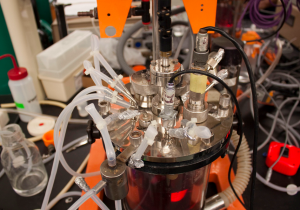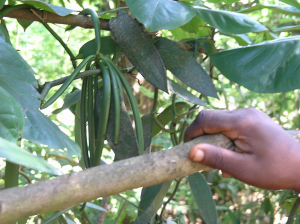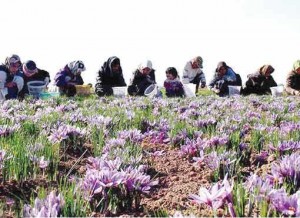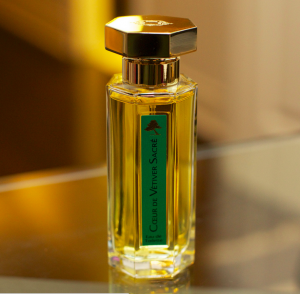
Ecover’s plans to use oil derived from synthetic organisms are only the beginning. Many synthetic biology (SynBio) companies have plans to produce food products using synthetic organisms as well. Because their technology is not regulated, many plan to market synthetic flavours and other ingredients as “natural.”
Because the technology is so new, no one can confidently know what the effects of substances produced by synthetic organisms on either human health or the environment. Will oils produced by synthetic algae, for example, be exactly the same as natural varieties? Could they contain other contaminants? We don’t know.
It’s also difficult to know what would happen if these synthetic organisms would do if they were released into the environment. If synthetic organisms escaped into the wilderness from the stainless steel vats to which they were confined, could we end up with vanilla-flavoured pollution or self-generating oil spills? We don’t know enough to be sure.
What we do know is that SynBio companies are targeting premium natural commodities and plan to make money by competing with farmers on price. If they are successful in marketing synthetically-derived flavours, untold numbers of farmers could be put out of business. In many cases, these farmers also care for the ecosystems in which their delicate crops grow. Without their livelihood, forests could be targeted for clearcutting and monoculture cultivation, or natural resource extraction, among other uses.
Here are a few examples of SynBio foods that are in the pipeline:
Vanilla

An estimated 200,000 people in the global south are involved in the production of vanilla. Vanilla orchids are a climbing perennial plants that typically grow in rainforests. Cultivation is extremely labour intensive, requiring hand pollination of each flower. To produce one kilogram of vanilla, 500 kilograms of vanilla pods must be harvested. In Madagascar, Mexico and Comoros, where farmers produce 75 per cent of the world’s vanilla, cultivation of vanilla provides a livelihood for people who have few economic alternatives.
The market for natural vanilla is valued at around $150 million annually. Evolva, a Swiss synthetic biology company, has announced plans to sell vanillin flavour produced by synthetic organisms in partnership with International Flavours and Fragrances (IFF). Evolva CEO Neil Goldsmith has pitched the plan as providing a sustainable source of vanilla flavouring. However, if the companies succeed at labelling their product as “natural,” the livelihoods of tens of thousands of farmers could be at risk.
Saffron

Saffron is known for its vivid red/orange hues and rich aroma. The world’s most expensive spice by weight, saffron consists of the dried stigma of the crocus flower. Between 90 and 95 per cent of the world’s saffron is produced in Iran. In 2009/2010, the country’s Khorasan Razavi province exported 57 tons of saffron worth $156.5 million to 41 countries. Saffron’s high price is a result of its labour intensive harvesting; it takes 40 hours of labour to extract enough crocus stigmas by hand to produce one kilogram of the spice. During the harvest, each hectare of crocus flowers provides work to up to 270 people per day.
Until now, there has been no synthetic alternative to Saffron. Evolva, however, is hoping to move the world’s saffron production from the foothills and valleys of Khorasan Razavi to industrial vats of sugar in Brazil. The company started researching how to create organisms that will produce each of the components the give saffron its flavour, aroma and colour. According to the company, it will have synthetic organisms producing a saffron imitation that will hit the shelves by 2015 or 2016.
Vetiver

GQ has called it the “perfect natural raw material for a masculine scent.” A distant relation of lemongrass, vetiver oil is known for its musty, woody scent and it fixative qualities, which means it helps a fragrance to last longer after it is applied to the skin. Vetiver can be detected in the “base notes” of many perfumes or colognes (including Chanel No 5), and is used in other cosmetic products as well.
The oil is derived from Vetiver grass, which originated in India, but is grown by farmers in Haiti, Indonesia, China, Japan, India, Brazil and Réunion (a French department in the Indian Ocean). Haiti is the world’s largest producer, and at one point supplied 60% of the world’s vetiver, employing 60,000 people directly and providing much-needed revenues in a country whose unemployment rate topped 40% in 2010. Vetiver is also valued for preventing soil erosion.
Allylix, a “renewable chemicals company” with offices in Lexington, Kentucky and San Diego, announced a product it is calling “epivone” in 2012. Epivone is structurally similar to beta-vetivone, one of the chemicals found in vetiver oil, “for use in fragrance applications.” It estimates the value of the existing market for these fragrances to be “a minimum of $20 million.”
Squalane
Squalane is a high-end moisturizing agent used in a variety of cosmetics, and in the manufacture of some vaccines. Originally extracted from shark livers, and up to six million sharks were killed annually to meet the worldwide demand. Purification techniques have since made it possible to extract squalane from olives, which are now the top source of squalane worldwide.
Amyris, a bay area synthetic biology company with production facilities in Brazil. It has engineered a yeast to produce farnesene, a chemical building block for chemicals used in products ranging from detergents and cosmetics to industrial lubricants and transportation fuels. Squalane is one of those products, and Amyris announced in 2010 that it was selling “NeossanceTM Squalane” to Soliance, a chemical supplier that serves the French cosmetic industry. A full list of which cosmetics currently contain squalane derived from synthetic organisms is not currently available. A recent New York Times article estimated that 300 products use SynBio squalane and specifically named Peter Thomas Roth Oilless Oil and Elizabeth Arden Visible Difference moisture cream.

 English
English Nederlands
Nederlands Français
Français